Beginnings
 The Hastings Fire Brigade was officially formed at a Public meeting on 23rd November 1942, held at the Hastings Hall.
The Hastings Fire Brigade was officially formed at a Public meeting on 23rd November 1942, held at the Hastings Hall.
The Brigade was registered with the then, Country Fire Brigades Board (CFBB) – the forerunner to today’s Country Fire Authority (CFA). Prior to the Fire Brigade being formed, the locals came together to help their neighbours in times of fire or emergency. Registration at the time with the CFBB allowed for 12 active and 6 reserve members.
The original Fire Station was a small shed located on the foreshore, where the Hastings Bowling Club is today. This shed was so small that everything needed to be moved out to allow the regular monthly meeting. The Brigade attended its first fire call at 10.30pm on Thursday 28th January, 1943 to a shed fire, approximately 2 miles from the Fire Station. Despite arriving some 5 minutes from the time of call, the shed was a total loss. Damage was recorded as £100. The equipment that was first issued included knapsacks, buckets, hand pumps and beaters. These were all put into a small cart that was then towed by one of the volunteers’ vehicles to the fire.

The Brigade’s first fire truck – a 1928 “Graham” truck was purchased for £125 on Dec 7th 1946. It had previously been used as a fruit delivery truck. At about the same time, the Authority issued the Brigade with a war surplus trailer mounted pump. These units were to serve the Brigade well until further fundraising allowed the purchase of a 1942 Chevrolet truck, in October 1952.
In the early days of the Hastings Brigade, there were not many fire calls but the Brigade members still kept themselves busy with training and running competitions. In fact, one of the first purchases was that of a competition running reel and ladder stand.
The 1950s
It was soon realized that the Brigade needed a bigger station and in 1950, a block of land was purchased for £60 in a muddy little side track called King St. Funds for the construction of a new station was raised by many social nights, concerts and some donations. Construction material was donated, and following many working bees and the tireless efforts of the Brigade members, the station took 4 years to complete. In order to complete the fit out of the new station, the Brigade sought funds from the CFA who, after much negotiation, provided £300 only after the members resolved to transfer the land title and ownership of the station to the CFA. The station in King St was to be the Brigades home for 45 years, although several modifications to the main building were needed in order to accommodate larger appliances through the years.
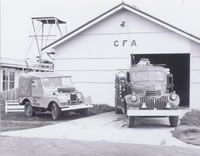 In 1952, a Rural Brigade was formed effectively forming two Fire Brigades operating out of the same station. At the time, having dual registration gave the Brigade(s) some leverage to request additional equipment from the Authority. Although dual registration was held, the officers and members remained a united entity with the election of officers invariably being the same for both Urban and Rural Brigades. It was not until 9th January, 1989 that it was resolved to disband the Rural Brigade and transfer all assets, boundaries and members to the Urban Brigade.
In 1952, a Rural Brigade was formed effectively forming two Fire Brigades operating out of the same station. At the time, having dual registration gave the Brigade(s) some leverage to request additional equipment from the Authority. Although dual registration was held, the officers and members remained a united entity with the election of officers invariably being the same for both Urban and Rural Brigades. It was not until 9th January, 1989 that it was resolved to disband the Rural Brigade and transfer all assets, boundaries and members to the Urban Brigade.
The 1950’s proved to be a time of great innovation, with the members involved in developing better gear and methods to improve firefighting capability. One area of keen interest was in Radio communications, where brothers Len and Ken Gibson, along with Bill and Bette Jones of Moorooduc Brigade, saw the introduction of ex Army VHF radios into firefighting vehicles.
The Brigade’s records show the first radio was on the air at 12:15pm on the 29th Oct 1953. Today, communications on the fireground back to a central base is almost taken for granted but this was an enormous achievement in the early 1950’s. Another innovation by the Brigade members was that of an automatic “turnout” system for fire calls. When a call came in, the station siren would sound, lights would come on and the doors would open automatically awaiting the arrival of volunteers and thus allowing a rapid departure from the station.
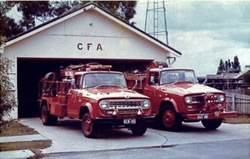 Once deemed to be effective, the idea was taken further by putting an automatic truck start in the system. Of course there was concern that someone would leave the truck in gear and the vehicle would take off without a driver, so a ”cut off” switch was installed should the vehicle move forward. Unfortunately, the cut off switch didn’t work as well if the truck was left in reverse. Well, the inevitable happened and on a fire call to the station one day, the members found the truck had reversed itself out the back wall of the station! The idea was subsequently dropped.
Once deemed to be effective, the idea was taken further by putting an automatic truck start in the system. Of course there was concern that someone would leave the truck in gear and the vehicle would take off without a driver, so a ”cut off” switch was installed should the vehicle move forward. Unfortunately, the cut off switch didn’t work as well if the truck was left in reverse. Well, the inevitable happened and on a fire call to the station one day, the members found the truck had reversed itself out the back wall of the station! The idea was subsequently dropped.
The 1960s-70s
Growth in the town of Hastings bought growth to the Brigade as well with new appliances and new ideas. During the mid to late 1960’s, the Gibson brothers were again pushing the boundaries of the day by pioneering the use of aerial reconnaissance or “fire spotting” at serious fires. The two brothers along with Ron Benton, would spend many long hours flying with Peninsula aero club aircraft out of the Tyabb airfield, assisting fire commanders with reports from the air.
It was during the 1970’s that saw major change in the Hastings Area. John Lysaghts Australia – a subsidiary of BHP (now Bluescope Steel) built a steel works to process steel slab into rolled finished product. At roughly the same time, ESSO built the Long Island Point Gas Fractionation Plant. For the Hastings Brigade, this meant additional risk and, with it, additional training and equipment. Fully encapsulated Gas Suits were issued to the Brigade in August 1977 and, recognizing the need for a larger station, land was purchased at 149 High St in 1972. It was a further 29 years before the Brigade would relocate to the High St site.
One idea that proved to be far more successful was that of an electronic siren for fire appliances. In the 1970’s, Len Gibson supplied on a trial basis, a new “heathkit” electronic siren for the Front Mounted Pumper. The story is told that this was the first electronic siren used on any fire appliance in the state of Victoria. Assistant Chief Officer (ACO) Tom Morrison reportedly inspected the Brigade and noted that the siren was a terrific idea. It was soon after that the CFA started supplying them on all appliances.
The 1980s
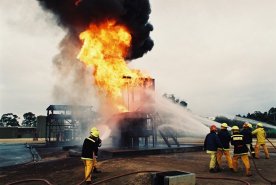 The 1980’s saw major change to the CFA in general after the devastating Ash Wednesday bushfires of 1983. In Victoria, 47 people died in the fires – including 13 firefighters. Significant changes were made to vehicle design, protective clothing, communications and tactics. For the Hastings Brigade, appliances were updated to more modern designs and talks of a move to a larger station continued.
The 1980’s saw major change to the CFA in general after the devastating Ash Wednesday bushfires of 1983. In Victoria, 47 people died in the fires – including 13 firefighters. Significant changes were made to vehicle design, protective clothing, communications and tactics. For the Hastings Brigade, appliances were updated to more modern designs and talks of a move to a larger station continued.
The 1990s
In the 1990’s the Brigade continued training for fires in specialized industrial facilities as well as the normal training requirements. Through Esso, the entire Brigade was sent to Esso’s Longford Fire Training facility. An increasing number and variety of calls saw the need to place an additional vehicle into service to carry all the extra equipment the Brigade required so in 1995, the Brigade decided to purchase a Hazmat/Salvage vehicle to further improve the Brigade’s capabilities. After significant fundraising, a cab/chassis was purchased and the CFA’s vehicle workshops at Ballarat fitted a body to suit the Brigade’s needs. On March 1996, the new Hazmat was commissioned.
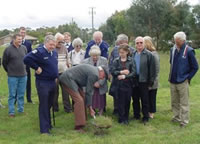 Towards the late 1990’s, plans were finally produced for a new station. The Brigade lobbied the CFA for extra room and in late 1999, the first sod for the new site was turned by the Brigades first captain, Cyril Ward who, at age 92, started turning not just one sod for the ceremony, but several!
Towards the late 1990’s, plans were finally produced for a new station. The Brigade lobbied the CFA for extra room and in late 1999, the first sod for the new site was turned by the Brigades first captain, Cyril Ward who, at age 92, started turning not just one sod for the ceremony, but several!
People
Whilst appliances and equipment are vital to a Fire Brigade, the organisations heartbeat is surely its people.
The Hastings Brigade has been fortunate to have within its ranks many dedicated and innovative people who, have given up their own time to assist the community in times of need and, have helped the Brigade grow into what we are today.
Not all of our members are firefighters – our Brigade Auxiliary provides invaluable support to the Brigade by organising fundraising as well as social functions.
Our honour boards proudly displayed at the Station show those who have served as Officers of the Brigade as well as Service awards for all members.
Fire Calls
The methods of alerting the volunteers to a fire call has changed significantly over the years. Initially, a hand operated bell mounted atop an old windmill was used. Later an electric siren set off from the Post Office manual telephone exchange.
Turnout times, it must be noted, in those days was in the order of 60 to 70 seconds given a number of members living or working close to the station.
In 1980, the Brigade purchased 5 radio pagers to alert the members. These pagers were set off by a Fire Reporting System, or FRS – a number of telephones linked together during emergency calls where the pagers and siren could then be set off for a fire.
During the mid 90’s, all Brigades in the outer Metropolitan area went to a centralized call taking and dispatch system where vehicles report to a Central control room rather than a local “Group” base.
Alerting today’s Firefighters is by a modern radio alphanumeric pager where calls are received through a centralised call taking and dispatch centre. With call details provided on the pager, every firefighter knows where and what sort of fire has been reported.
- In 2008/09, the Brigade attended 262 calls.
- In 2009/10, the Brigade attended 218 calls.
- In 2010/11, the Brigade attended 210 calls.
- In 2011/12, the Brigade attended 286 calls.
- In 2012/13, the Brigade attended 230 calls.
- In 2013/14, the Brigade attended 232 calls.
- In 2014/15, the Brigade attended 241 calls.
- In 2015/16, the Brigade attended 265 calls.
- In 2016/17, the Brigade attended 264 calls.
Major Fires
The Hastings Brigade has always been involved in large fires within its local area but has also been a member of support forces throughout the state and beyond ( Major Fires Statewide ). Some of those include:
East Gippsland (1962)
Yea (1969)
Balranald NSW (1975)
Bairnsdale (1978)
Combienbar/Cann River (1980)
NarNarGoon and Kinglake (1982)
Ash Wednesday (1983)
Porepunkah (1985)
Warburton (1991)
Langwarrin / MtMartha / Arthurs Seat (1997)
North East Victoria (1998)
Lithgow (2002)
Omeo (2003)
Anakie and Erica (2006)
Swifts Creek (2007)
Boolarra / NarreWarren / Kinglake (2009)
Protective Clothing
 In our early days, clothing and protective clothing was self supplied with normal street clothing being worn to fires with nothing more than a red arm band with “FIRE” on it being used to identify the Brigade member. Fortunately today, we are equipped with the latest structural protective clothing for structure fires and the like as well as our familiar “yellow” turnout gear that we use for wildfire.
In our early days, clothing and protective clothing was self supplied with normal street clothing being worn to fires with nothing more than a red arm band with “FIRE” on it being used to identify the Brigade member. Fortunately today, we are equipped with the latest structural protective clothing for structure fires and the like as well as our familiar “yellow” turnout gear that we use for wildfire.
Today
Today, the Hastings Fire Brigade has 61 volunteer members and occupies a purpose built, modern fire station at 149 High St. Officially opened in November 2001, the station is equipped with a 4 bay motor room, meeting room, workshop and amenities.
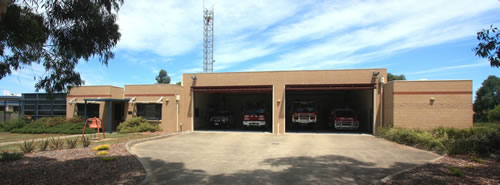
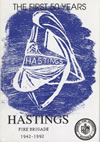
Compiled by Alan Millar
With special thanks to Allan Monti – author of Hastings Fire Brigade – the First 50 Years. 1942 – 1992.